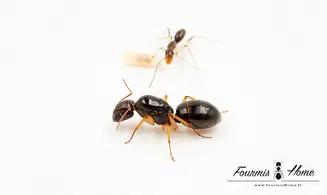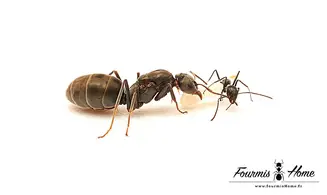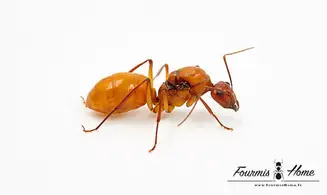Latin name: Iridomyrmex anceps
Taxonomy: Subfamily: Formicinae, Tribe: Camponotini
Breeding level: Beginner, just provide a good temperature
Geographical distribution: Australia
Habitat: Dry forest
Colony forms: Monogynous and subsequently accepts new queens
Queen: Size: 7 - 8mm Color: Black
Workers: Size: 3 - 4mm Color: Black
Major: No
Male: Size: 3mm Color: Black
Food: Honeydew and insects: such as flies, mealworms, mosquitoes and small locusts; also fruit
Humidity: Hunting area: 30 - 50% Nest: 50 - 60%
Temperature: Hunting area: 20 - 32 ° C Nest: 24-28 ° C
Hibernation: No, but a winter break from November to March at room temperature is recommended
Type of nest: Plexiglas nest, nest with tubes, reconstituted stone nest.
Description: This is a small dark brown/black ant of about 3-4 mm. It is a vigorous, fast and aggressive species that invades new habitat very quickly and will attack any other species in its territory, including the aggressive fire ant.
They prefer to nest in warm open and exposed spaces where they will actively dig a nest deep underground. The main nest is usually about 20–30 cm below the ground; however, they will frequently gather mature brood near the surface where the warmer temperature will hasten its development.
Single queens with a size of 7-8 mm are able to found an independent colony, and once the first workers emerge, the young colonies develop very quickly. As the colony grows, it will accept additional queens.
Mature colonies are densely populated and have long trails leading between several different nesting sites. Other feeding trails often lead to bushes/trees where they cultivate and nurse aphids. They also actively hunt other insects. Their rapid speed and rapid recruitment of workers for any food source means that they generally outperform other local species.
Summary: An easy-to-keep species that will take most food and reproduce very quickly.
Development: Massive swarming
Foundation: Occurs in a cloistered manner (without feeding) Development: 35 days from egg to worker (depending on temperature)
Size of the colony: 100,000 individuals, the queen can reach the age of 10 years.









